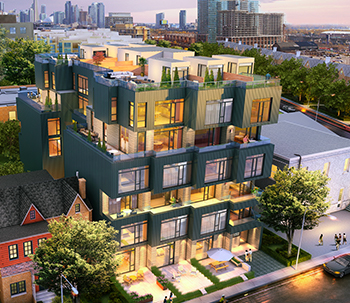Toronto Star features two of our projects and talks mid-rise wood-frame buildings with David Moses:
For more on mid-rise wood buildings, visit 6wood.ca.
From the outside, they might look like any other mid-rise condominiums springing up in Toronto neighbourhoods, but at their core, they are the vanguard of a trend changing construction in Ontario.
Wood-framed buildings are common in single-family homes and townhomes but have been limited to four storeys. Changes that were made to the Ontario Building Code in January 2015 now allow for up to six storeys, and the first such projects in Toronto are being built this year.
While there are up to 15 multi-storey wood buildings in construction across Ontario, the first in the city of Toronto will be Heartwood The Beach, at 1884 Queen St. E., at Woodbine Ave. Work is expected to start in June, said Quadrangle architect Richard Witt.
Witt is also working on 60-80 Atlantic Ave. in Liberty Village, a five-storey, timber-framed commercial office building — a back-to-the-future design which is the first in nearly 100 years.
“It’s five storeys instead of six, because commercial buildings have higher ceilings,” he said. “So there was a height limit. Given the location in Liberty Village and the kind of occupancy who wants to come in there, what they wanted was a brick-and-beam office building. We decided to reinvent the brick-and-beam office building for the 21 century.”
Next up will be Cabin Toronto at 45 Dovercourt Rd., a six-storey building with 25 units, each with two floors ranging from a generous 895 square feet to 2,638 sq.-ft., squeezed on to a 60- by-110-foot lot which will appeal to young couples and those with families looking to stay in the city.
It is in the rezoning stage and is 70 per cent sold. It’s a uniquely designed building in the form of cubes stacked on top of each other by RAW Design director Roland Rom Colthoff.
“It came about because we’d done another project at 455 Dovercourt which converted an institutional building to office and added two storeys of residential on top,” he said. “We realized we could call it a four-storey building even though it’s quite tall. When we said we could do it out of wood, the client was over the moon because their building costs came down.”
It made logistics of getting materials to the site and installing them much simpler, and the experience there made it natural to consider wood as the core structure.
“At Cabin, wood was a natural selection because of the size of the site and the constraints,” he said. “Unlike pre-cast concrete and steel, you don’t have to worry about places to stage the material. You just have your lumber truck show up and get to work.”
The trend toward wood was kicked off in British Columbia and Quebec, supporting their forestry industries by looking at their building codes and new technologies in 2009.
Changes to the National Building Code which followed were controversial, with the Canadian Concrete Masonry Producers Association and the Canadian Institute of Steel Construction both pushing back, protective of their position as the materials of choice for mid-rise and higher structures.
Safety issues were front and centre with dire predictions that residents in wood-frame buildings would be a higher risk to fire deaths and damage, stray bullets, termite damage and vulnerable in the event of wind storms and earthquakes.
However, there are safeguards in place: stairways and elevator shafts must be made in noncombustible materials like concrete, block or steel, sprinkler systems are required throughout, while drywall and other materials used in finishing interiors provide fire resistance for a specific time before the wood itself is in danger.
Also, in most cases, the wood being used is an engineered product — much like engineered wood floors are a combination of wood and other materials laminated together — and is also treated to be fire resistant.
“The sprinkler stops the fire at source,” said industry group Wood-Works’ technical adviser Steven Street. “The drywall and the other materials are there in a worst-case scenario, in case of a total failure of fire suppression.”
There’s nowhere to go but up, says structural engineer David Moses who believes it won’t take long before we’ll see double the current six-storey limit.
“We’re already in talks now around 10 to 15 storeys, and that’s what I’d like to see, especially in Toronto,” he said. “What we learn from that we can apply to a 20-storey highrise.”





